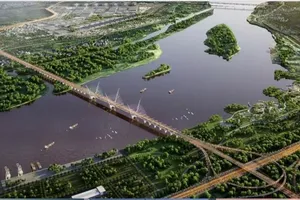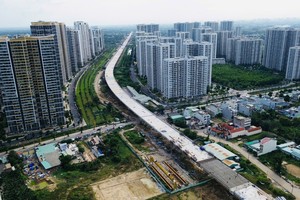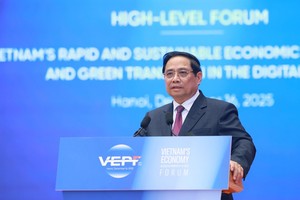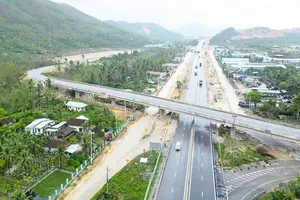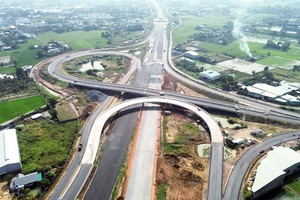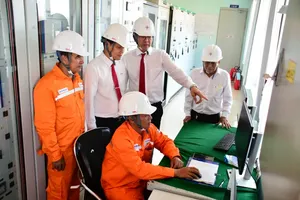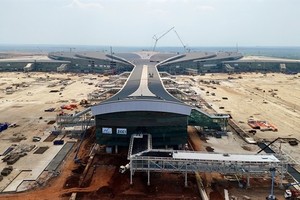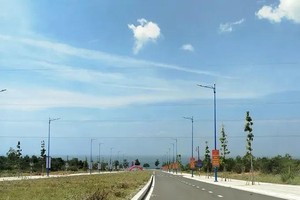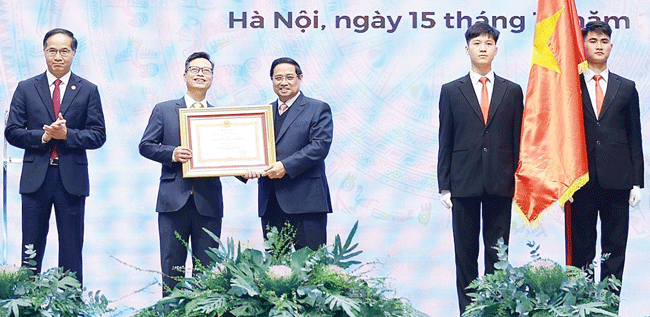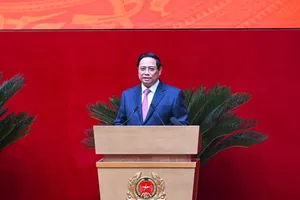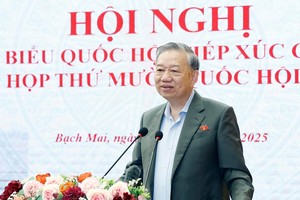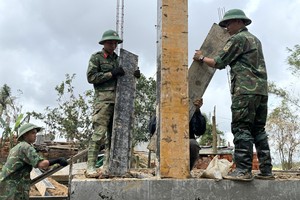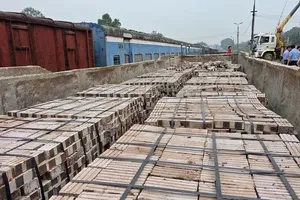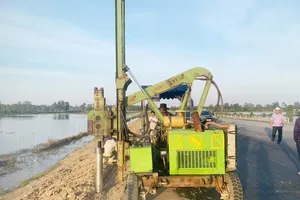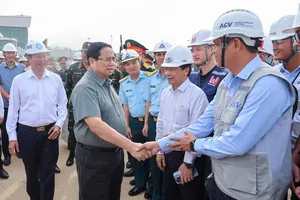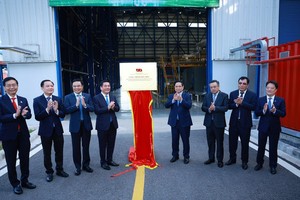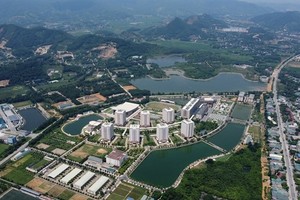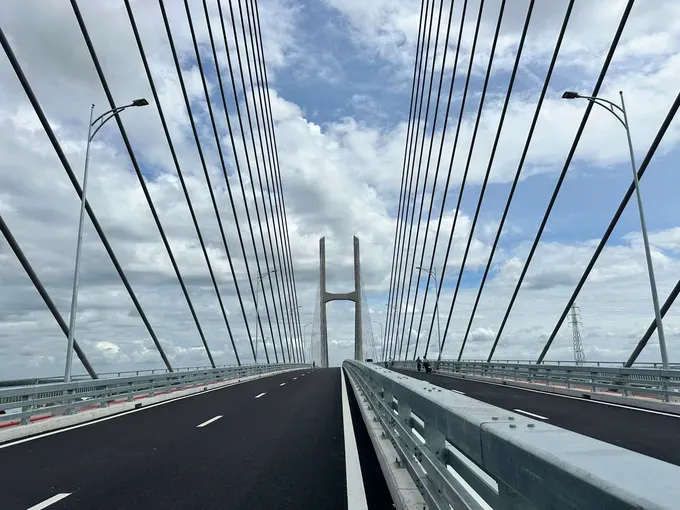
The 250 infrastructure projects are set to launch simultaneously across 34 provinces and cities, backed by a total investment of over VND1.28 quadrillion (US$51.2 billion) – equivalent to more than 10 percent of the national GDP.
This monumental undertaking is not only grand in scale, befitting the occasion of the 80th National Day on September 2, but it also serves as a powerful affirmation of the Party and State’s determination to establish infrastructure as a core pillar for accelerated growth in this new era.
Transportation projects continue to dominate the list, with 59 new works being launched or inaugurated, a clear signal of the strategic priority placed on developing the nation’s circulatory system.
Among the standout projects in the North are Gia Binh International Airport in Bac Ninh Province, with a staggering total investment of over VND120 trillion ($4.8 billion), and the massive Ring Road 4 project for the capital region, valued at over VND56 trillion ($2.24 billion).
Meanwhile, in the Central and Southern regions, six key sections of the North-South Expressway’s eastern route are now complete, Rach Mieu 2 Bridge is officially open to traffic, and a host of other strategic projects are breaking ground. These include new expressways from Gia Nghia to Chon Thanh and from Dau Giay to Tan Phu, as well as crucial expansions of the HCMC-Long Thanh Expressway and Ca Mau Airport.
Together, these projects are forging an unprecedentedly seamless North-South and East-West transportation network. They are linking new economic spaces and transforming what were once simple administrative boundaries into unified axes of development.
As Deputy Minister of Construction Le Anh Tuan aptly noted, this simultaneous rollout of major projects does more than just addressing travel needs. It lays the groundwork for unifying resource management, unlocking the unique potential of each region, and ensuring the unimpeded flow of goods, labor, and services. Ultimately, the goal is to drive down logistics costs and forge new competitive advantages for the nation.
The coastal region of the Mekong Delta is on the cusp of a major transformation with two large bridge projects coming online, finally connecting a long-divided eastern corridor and unlocking vast opportunities for trade and socio-economic growth.
For weeks, every afternoon, dozens of eager residents have gathered at the abutments of Dai Ngai 2 Bridge, watching a decades-long dream take shape before their eyes. Located on the lower Hau River, Dai Ngai 2 Bridge crosses the Tran De estuary, connecting Dung Islet to the mainland. With a total investment of nearly VND4 trillion ($160 million), the project was completed in a remarkable 20 months.
Chairman Tran Van Lau of the Can Tho City People’s Committee explained the bridge’s significance. “Together, the Dai Ngai bridges will complete the critical National Highway 60, forming a coastal corridor that shortens the journey to HCMC by about 80km”, he said. “This will attract investment and, for Can Tho City, it will shatter the isolation of Dung Islet, an area earmarked for high-end tourism and green agriculture.”
As the final concrete segments of Rach Mieu 2 Bridge were joined, connecting the banks of the Tien River, a wave of joy and emotion washed over dwellers of Vinh Long and Dong Thap provinces. For years, this area has been plagued by the infamous “bottleneck” of the original Rach Mieu Bridge, a source of endless traffic jams and delays.
The dream of a modern bridge system crisscrossing the great rivers of the Mekong Delta, once a seeming luxury, is now becoming reality. Rach Mieu 2 Bridge, completed ahead of schedule, stands as a new symbol of the region’s developmental resolve.
According to Chairman Vo Tan Loi of the Dong Thap Durian Association, the new bridge is a game-changer. “It will make transporting our fruit and seafood to HCMC far more efficient, cutting time and logistics costs”, he noted. The tourism industry is equally excited, as smoother travel is expected to revive garden tours and riverside homestays that have struggled since the pandemic.
“The new bridge will alleviate pressure on the old one, significantly boosting capacity”, Director Nguyen The Hong Trung of the Dong Thap Department of Construction stated. “This isn’t just a key transport project; it’s a strategic catalyst expected to unlock the socio-economic potential of the entire Mekong Delta, long suppressed by infrastructure choke points.”
These two bridges, Rach Mieu 2 and Dai Ngai 2, are powerful symbols of the Mekong Delta’s transformation. They are helping to eliminate the region’s status as a transportation “remote area”, extending the dream of a dynamic, thriving delta that is developing sustainably alongside the rest of the nation.
A palpable sense of anticipation surrounds tomorrow’s August 19 ceremonies. The event is awaited not just for its colossal scale, but for its powerful message of a nation committed to unlocking its potential by overhauling its infrastructure. This has reinforced public faith in the country’s growth prospects.
However, this very trust places immense pressure on the Government. The key challenge now is to ensure these historic projects deliver on their promises and become true engines of national development, effectively propelling Vietnam into a new era of prosperity and strength.
Also, in the past, too many projects have been inaugurated with great fanfare only to operate sluggishly, fall into disrepair, or even be abandoned, causing public frustration. Projects, once completed, demand effective management and operation.
For those now breaking ground, managing agencies, investors, and contractors must maintain rigorous oversight to ensure quality and adherence to timelines. Transparency is paramount to prevent the all-too-common pitfalls of budget overruns and delays that erode investment efficiency.
The joy of a groundbreaking ceremony is fleeting. It’s the long-term satisfaction of the people who use and benefit from these projects that we truly seek, for that is the most honest measure of any project’s worth.
